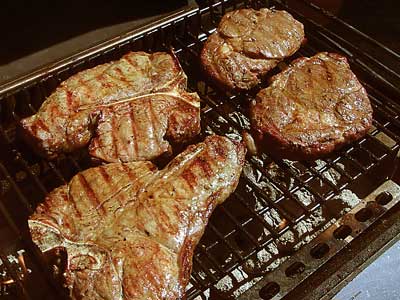Story and Photographs by Rick Browne, Ph.B.
As with any cooking style worth its salt (or BBQ rub, as it were), changes are inevitable if that style is to survive and grow and maintain its popularity. And that’s why barbecue grillers are expanding what they cook (i.e.: burgers, hot dogs and ribs) to include more exotic fare, cooking up bison, venison, elk, rabbits, rattlesnakes, wild boar, antelope, and—yes, Rudolph—reindeer.
If those entrees aren’t exotic enough for you, how about a plate of yak, a bowl of alligator stew, a llama burger, a rack of musk ox, or a turtle casserole?
It seems like we’ve gone back to the woods, retracing the culinary steps our ancient ancestors trod around the campfire as we reach out for ever more exotic meats to grill up in our backyards. In fact, annual sales of wild game online have wowed the financial world as revenues have skyrocketed from $110 million to $340 million in just a few short years.
“Our growth has doubled in the fast five years, averaging almost 20 percent a year,” says Russ McCurdy, the owner of Seattle Exotic Meats. “Especially with bison, which seems to be most popular in the Western states, but also with rattlesnake, kangaroo, and elk.”
If you’re a burger boy, they offer burgers made from 11 different species for your tasting pleasure, including alligator, yak, goat and kangaroo.
Nicky Foods in Portland, Oregon, has by far the largest selection of game available online, and has also seen their sales rocket upward in the past five years. “As chefs and home cooks learn more about how to cook game, and the health benefits of foods like bison and ostrich, we’ve seen a substantial increase in the interest in cooking these at home and in upscale restaurants,” says owner Geoff Latham.
To order from their website, you need to download a PDF catalog that is ten single-spaced pages long, then you can order up cuts of meat from an incredible list of game. The bison (buffalo) section alone has 54 cuts of meat listed, everything from bone-in rib eyes and short ribs to buffalo bull fries. Started as a small company selling rabbits to local restaurants, their list of wild game and fowl now numbers over 100 items and is constantly growing.
If you love sausage , they have 32 varieties—including some intriguing mixtures like smoked duck with apple brandy, buffalo bratwurst with burgundy wine, and pheasant with cognac and hazelnuts. Yummy!
Prices for these exotic entrees ordered at most web sites online are higher than regular beef or pork to be sure, but people are finding not only a significant taste difference but, in the case of bison particularly, tremendous health benefits.
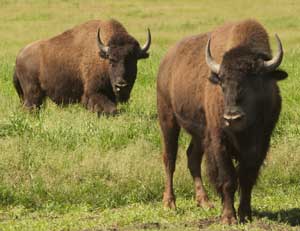
“Bison fat contains 4 times the folic acid of any other animal,” shares Skip Sayers, who owns American Gourmet—yet another website dedicated to wild game meats. “And we’re finding doctors who recommend adding bison to patients’ diets because some researchers feel it helps prevent cancer and heart problems. One medical study found that if you eat three 4-ounce portions of bison a week, for 24 weeks, your LDL (bad cholesterol) level would drop by 45%.”
Sayers adds, “Scientists also did a study of Native American plains Indians and found that while some died of tuberculosis and other infectious diseases, they never found any evidence of cancer or heart or stroke problems. And their diet consisted mainly of bison.”
On that same track, ostrich and emu—both red-meated birds—have always been touted for their cholesterol and fat-free properties, although most web sites I visited said sales of these birds has fallen off dramatically. One site manager suggested it might be because of a fear of avian flu, but others said that it was more a problem of availability.
 The only problem with ostrich and emu is that both are becoming hard to find. For a while both birds offered up an answer to our hunger for low-cholesterol red meat, but in the past few years both have been harder and harder to get as more and more ostrich or emu farms have gone out of business.
The only problem with ostrich and emu is that both are becoming hard to find. For a while both birds offered up an answer to our hunger for low-cholesterol red meat, but in the past few years both have been harder and harder to get as more and more ostrich or emu farms have gone out of business.
In Portland, OR, where I often dine, several upscale restaurants say they would serve and promote these game birds more, but they are having trouble getting product consistently. Emu is valued for its oil— which is good nutritionally as well as topically—for pain and stress. But they are relatively expensive to raise, especially when people need to be coerced and prodded into buying this non-poultry-looking red meat.
While almost all game meats are lower in fats and cholesterol than more traditional meats, cooking (especially grilling) can be tricky if not done right. The lack of fat on one hand is good, but fat is what adds moisture to meat when it’s cooking. Take away the fat and you must cook smarter, otherwise your steaks, ribs and chops will taste and look like old shoe leather.
I highly recommend that you never cook elk, venison, moose, caribou, reindeer, musk ox, yak, or bison past medium rare. If you do you will not like the dry, tasteless result. Cook the meat over high heat to sear in the juices, then move it to an indirect side of the grill and finish cooking until you reach the medium rare temperature inside.
Canada goose looks remarkably like a beef tenderloin, ostrich fillets can easily be mistaken for filet mignon, and pulled pork from a wild boar (properly flavored and cooked) is an identical twin to a sandwich made from domestic pork, despite one pig living on a ranch where it’s pampered, and the other porcine literally having to fight and scrape for every morsel of food.
You can, of course, stew, brine or marinate these meats to add moisture, or wrap them in bacon to add both fat and moisture. But that (especially the bacon trick) adds in fat loaded with cholesterol. A simpler answer is just to cook it right.
For those who want to try it all, Brentwood Trading Group offers their “Exotic Meat of the Month Club” where you receive a different selection each month for a year. At $799 it is perhaps a bit pricey, but for the guy who has everything and loves to cook…
Caveat emptor (buyer beware)—a hidden (at least initially) cost of ordering game meats online hits you right in the pocket when you go to check out. Since all game meats are perishable, and since shipping regulations require a minimum of two-day shipping, costs for those antelope steaks and buffalo burgers can be shockingly high.
But since you’re probably not going to be ordering exotic meat every week, or even every month, the higher costs can be tolerated. And several of the online companies are working at getting two-day UPS service at a reduced rate for food items. Your best bet is to check with the company you’re buying from before you click that final “Purchase Products” button on your computer.
Bison appears to be the meat of the future; ranchers and web sites can’t keep up with the demand, selling as much as they produce, and they could easily sell double the current numbers. The public appears to be demanding buffalo meat, and it’s possible to find cuts of bison in upscale store chains like Whole Foods.
From a low point of just 1,000 animals to today when there are approximately 400,000 animals on ranches and farms in North America, the mighty bison appears to have come back in force and may just be the leading force in a new wave of healthy barbecue.
For my money, there is nothing like a bone-in rib-eye buffalo steak. It has all the taste of the finest aged prime beef with less than 1/3 the fat, is loaded with vitamin B12, selenium, zinc and phosphorus, low in sodium, and when properly cooked is incredibly tender and juicy. And they call this an exotic meat?
One thing to remember is that wild game is absolutely organic. No tenderizers, antibiotics, vitamins, steroids or flavor-enhancers are in your moose burger or venison roast. Try saying that about the pre-packaged, colored, water-infused, chemically saturated meats you buy in your local supermarket.
That’s the meat we should be terrified of.
SOME OF THE GAME AND GAME BIRDS AVAILABLE ONLINE:
Alligator
|
Pheasant
|
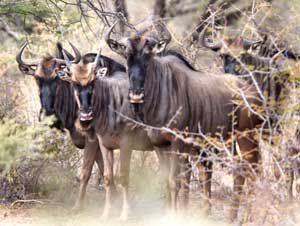
|

BBQ’d Venison Loin Chops
with Apricot-Mango Chutney
8 venison loin chops
salt
pepper
Baste:
1/2 cup olive oil
2 cloves garlic, chopped & lightly browned
1 sprig rosemary
1 sprig thyme
2 teaspoons black peppercorns
Salt and pepper loin chops, then brush chops with olive oil mixture. Place on a heated grill and cook for 4-5 minutes per side until the meat is cooked the way you like it, basting every time you turn the meat. Let loin chops rest for 2 minutes before serving.
Accompany venison chops with the apricot-mango chutney (below).
Serves 4
Apricot-Mango Chutney
4 medium apricots, diced
3 medium mangos, peeled & diced
8 oz. sugar
2 cups white wine vinegar
1 teaspoon cardamom
1 teaspoon dried ginger
1 teaspoon salt
1 teaspoon white pepper
1 red bell pepper, finely diced
8 ounces golden raisins
1/2 red onion, finely diced
Combine all ingredients in a saucepan and simmer, uncovered, for 45 minutes. Cool, then place in clean jars and refrigerate. Warm up to use with meat recipes.
Breast of Wild Goose
with Lingonberry Sauce
1 full breast of wild (or domestic) goose, about 3 pounds
Marinade:
1/2 cup olive oil
1/2 cup water
1/4 cup apple cider vinegar
3 tablespoons Worcestershire sauce
1 teaspoon garlic powder
1 teaspoon onion powder
Sauce:
1 12-ounce jar lingonberry preserves
1/2 cup gin
Marinate breast for 2 hours in refrigerator, remove, dry the breast and place it on a grill, preheated to 350 degrees F. While the goose is marinating, mix the gin and preserves and heat in a saucepan over medium heat, stirring often, until the mixture thickens.
Boil the marinade for 10 minutes, then use it to baste occasionally, until thw goose breast reaches an internal temperature of 160 degrees F. Remove and allow breast to rest for 15 minutes, covered in foil, before slicing.
Serve with warm lingonberry-gin sauce on the side.
Serves 6
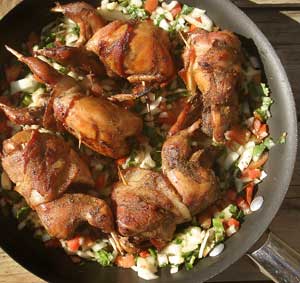
Quail with Honey BBQ Sauce
10 whole quail
1/4 cup flour
1/2 teaspoon garlic salt
1/4 teaspoon paprika
1/8 teaspoon pepper
10 strips bacon
2 tablespoons vegetable shortening
Clean the birds and set aside.
Place flour, garlic salt, paprika, and pepper in a plastic or paper bag; add the quail breasts and shake until meat is well coated.
Wrap a large slice of bacon around the breast of each bird.
Heat shortening in a medium skillet and brown the breasts on both sides.
Let them cook until just browning all over, about 5 minutes per side, then remove the birds to a platter and keep them warm while preparing the sauce.
Serves 3-4
Honey BBQ Sauce
1 medium onion, sliced
1 tablespoons shortening
2/3 cup water
2 teaspoons cornstarch
1 cup Cattlemen’s Golden Honey BBQ Sauce
2 teaspoons soy sauce
Cook and stir the onion until crisp-tender in the same skillet used for browning the quail. Blend water, cornstarch, BBQ sauce and soy sauce and pour into the skillet. Cook and stir constantly until the sauce thickens and boils. Continue stirring and allow sauce to boil for one minute.
Add the quail to the sauce, heat through, and serve on a bed of freshly made pico de gallo.
 Wild Boar in Peanut Sauce
Wild Boar in Peanut Sauce
2 to 3 pounds of wild boar cut into bite-sized or serving-sized pieces
3 onions, chopped
3 small tomatoes, peeled and chopped
1 cup peanut butter (natural or homemade)
salt to taste
black pepper to taste
oil for frying
Heat a few spoonfulls of oil in a large pot. Add the meat and fry it until it is browned but not done. Reduce heat. Add water, salt, and pepper and simmer for about half an hour.
Add the tomatoes and onions and contine to simmer until the meat is done and becoming tender.
Remove some of the liquid and mix it with the peanut butter to make a smooth sauce. Add this to the meat-tomato-onion mixture.
Continue to simmer on very low heat until the meat is very tender.
Serves 6-8
Teriyaki Buffalo Rib-eyes
4 buffalo rib-eye steaks, 12 ounces each
(most wild game distributors also sell 4-, 8-, and 10-ounce steaks)
1 clove garlic, minced or pressed
1 teaspoon ground ginger
2 tablespoons brown sugar
2 tablespoons soy sauce
2 tablespoons lemon juice
2 tablespoons salad oil
1 tablespoon instant minced onion
1/4 teaspoon black pepper
Combine soy sauce, garlic, brown sugar, lemon juice, oil, onion and pepper. Pour over the steak, cover and refrigerate for 6 hours or (ideally) until the next day.
Lift steaks from the marinade and drain briefly, save marinade and boil it for 10 minutes in a small saucepan. Place the rib-eyes on a barbecue and grill for 6-8 minutes for medium rare, turning once and basting with reserved marinade.
Serve the buffalo rib-eye steaks with barbecued beans, barbecued corn on the cob, and Indian fry bread.
Serves 4 BIG eaters or 8 small ones
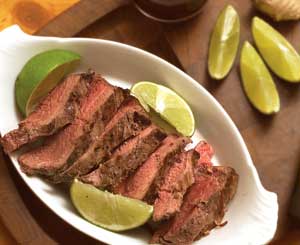
Alice Springs Ostrich Medallions
2 pounds ostrich tenderloins
Marinade:
1/2 cup soy sauce
1/4 cup lime juice
2 tablespoons rice wine vinegar
1/4 cup orange juice
1 tablespoon brown sugar
1 tablespoon honey
1 teaspoon minced garlic
1/4 cup chopped scallions
1/2 teaspoon fresh ground ginger
1 teaspoon olive oil
pinch of nutmeg
sea salt to taste
citrus pepper to taste
2-3 tablespoons chilled butter
Slice tenderloins into 1-inch-thick medallions, place them on a cutting board, cover with plastic wrap, and pound lightly to flatten and tenderize the meat. In a large bowl whisk together all marinade ingredients and pour into a Ziploc bag, add the ostrich, and marinate the medallions for 8-10 hours in the refrigerator.
Drain the meat, reserving the marinade, and place the meat on a platter, cover with plastic wrap, and let it come to room temperature while you oil or spray the grill.
Place an aluminum foil smoke packet on the coals (or medium gas flame) and when the wood chips begin to smoke, put the medallions on the grill.
In a medium saucepan over high heat, boil the remaining marinade for ten minutes. Reduce the heat to its lowest setting and keep the marinade warm. Just before serving the ostrich, cut the butter into small chunks, add them to the sauce, and whisk into the mixture until smooth.
Grill the ostrich over medium coals or a gas fire (400 to 500 degrees F) until medium rare, approximately 1-2 minutes per side. Do not overcook, as ostrich is very lean.
Place the medallions on a heated platter, cover with foil, and let the meat rest for 2-3 minutes. Serve with the sauce on the side.
Serves 4

